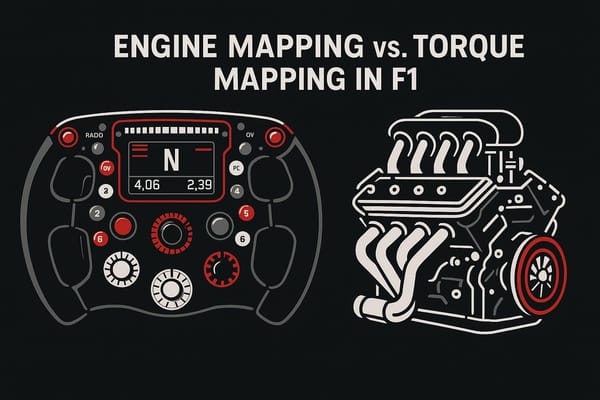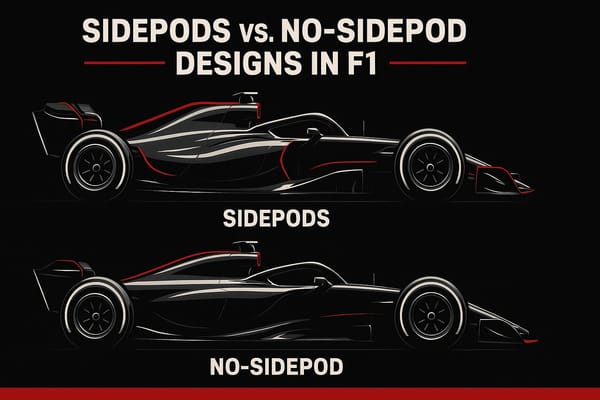Pre-Race Checklist: Understanding F1 Grid Procedures
Explore the meticulous grid procedures that F1 teams follow before a race, ensuring peak performance and compliance with FIA regulations.

Formula 1 grid procedures are a race against the clock. Teams and drivers have just 30 minutes before the race to fine-tune their cars, ensure compliance with FIA rules, and mentally prepare for the intense competition ahead. Missing a single step can mean penalties or even starting from the pit lane.
Key Pre-Race Timeline:
- T-30:00: Cars take grid positions; late arrivals start from the pit lane.
- T-15:00: Pit lane closes.
- T-10:00: Non-essential personnel leave the grid.
- T-5:00: Final tire fitting completed.
- T-3:00: Last technical adjustments made.
- T-1:00: Grid cleared; engines running.
Why It Matters:
- Tire and Brake Prep: Optimal tire temperature (~210°F) and brake readiness are critical for performance.
- FIA Compliance: Strict rules govern everything from grid positioning to engine starts.
- Formation Lap: Drivers warm tires, check systems, and assess track conditions.
Precision, timing, and teamwork are essential. A flawless execution of grid procedures sets the stage for a strong race start and can make or break a team’s performance.
F1 Explained: What Do Teams Do on the Grid?
FIA Rules and Timing

The FIA enforces a strict schedule and set of rules to ensure safety, fairness, and technical precision during pre-race and race activities. These guidelines are designed to maintain order and compliance among teams and drivers.
Pre-Race Time Schedule
A detailed countdown helps coordinate all pre-race events effectively.
| Countdown | Action |
|---|---|
| T-40:00 | Pit lane opens, allowing track access |
| T-30:00 | Cars must be in their grid positions (late arrival results in a pit lane start) |
| T-10:00 | Grid is cleared except for team mechanics, race marshals, and drivers |
| T-3:00 | Tires must be fitted to the cars |
| T-1:00 | Engines must be running |
Team Regulations
Teams are required to follow specific FIA rules during the race start. The race begins with ten red lights in two rows of five. These lights illuminate in pairs from left to right at one-second intervals. After a random pause of 4 to 7 seconds, all the lights go out simultaneously, signaling the start.
Key technical rules include:
-
Gearbox Usage
Teams must use the same gearbox for five consecutive races. Replacing a gearbox results in a 5-place grid penalty. -
Engine Start Procedures
If a car stalls on the grid, the driver must notify the grid marshal immediately. The team can either accept a 10-position penalty to join the race or start from the pit lane, allowing time for adjustments like replacing tires or addressing engine problems.
Drivers are required to maintain set gaps, with overtaking only allowed under race control's direction. During rolling starts, cars must stay in their assigned grid order until crossing the control line, and acceleration is restricted while the red signal lights are displayed.
FIA grid marshals monitor car positioning to ensure compliance with all technical and procedural rules. These detailed protocols are critical for maintaining safety and order, while also influencing race strategies during one of Formula One's most crucial phases.
Car Setup and Technical Checks
Grid Position and Formation
Grid positions are determined by qualifying results (Q1–Q3), with the fastest Q3 lap securing pole position. During the formation lap, teams track live telemetry data, including brake and tire temperatures, engine performance, radio communications, and the status of key components. This data helps finalize the car's readiness and ensures everything is in place for the race.
Pre-Race Car Checks
Before the race begins, teams perform detailed technical checks following FIA protocols. These include verifying brake disc thickness and ensuring tires are mounted by the five-minute signal. If telemetry during the formation lap shows any components operating outside acceptable limits, teams may choose to retire the car to protect the engine, as on-track repairs are not allowed. FIA officials also conduct their own inspections, checking electronic systems, fuel composition, and tires to confirm compliance with safety and performance regulations.
These inspections are the final step in pre-race preparations, ensuring that every car meets strict safety and performance standards. Teams use this data to fine-tune their race strategy and confirm their cars are ready for the intense competition ahead.
Team and Driver Tasks
Team Responsibilities and Communication
Smooth grid formation relies on precise coordination between team members and drivers. Each team member has specific duties, supervised by the chief mechanic and senior race engineer.
Here’s how the team operates:
- Technical Staff: Mechanics handle cooling fans, tire blankets, and connect the car for real-time monitoring.
- Engineering Team: Race engineers check key settings like steering wheel configurations and front wing angles to ensure the car is ready for a strong race start.
- Power Unit Specialists: These engineers manage the engine start sequence.
Communication is streamlined through headset channels, with the race team manager staying in direct contact with the drivers. This setup ensures quick updates on pre-race procedures and compliance with sporting regulations.
While the team focuses on technical preparation, the driver simultaneously carries out essential pre-race routines.
Driver Pre-Race Actions
As the team wraps up their checks, drivers follow a series of critical steps during the warm-up lap. These include:
- Staying within ten car lengths of the car ahead.
- Maintaining the pace set by the pole-sitter.
- Weaving to warm up tires.
- Collaborating with the engineering team for final system checks.
This phase requires flawless coordination between the car and driver. Drivers aim to reach an ideal tire temperature of about 210°F to ensure peak performance at the start of the race.
Race Preparation Decisions
After completing pre-race technical checks, teams move on to crucial decisions for race preparation.
Last-Minute Setup Changes
Teams rely on track conditions and performance data to make final adjustments within parc ferme rules.
Key areas of focus include:
- Suspension settings: Adjustments to suspension setups are made within regulatory limits. For example, during the 2025 F1 Miami Grand Prix Sprint race, Red Bull altered its suspension, resulting in a pit lane start.
- Tire management: Real-time track data, collected at over 1,000 data points per second, helps teams fine-tune tire pressures and run predictive simulations.
These fine-tuned adjustments play a critical role in adapting to external conditions and influencing grid performance.
Grid Procedure Effects
Weather and track evolution are major factors that shape race start strategies. Teams must account for several variables during pre-race preparations:
- Temperature impact: Track temperature has a huge effect on tire performance. For instance, overcast weather can drop track temperatures by as much as 68°F, requiring teams to adjust their warm-up protocols.
- Track evolution: As rubber builds up on the track over the weekend, surface grip improves. Teams need to consider these changes, particularly after any track modifications.
"In Formula 1 (F1) racing, every millisecond counts, and weather conditions can drastically impact the outcome of a race." - Michael Luzich
To stay ahead, teams use advanced weather modeling systems to predict conditions and create contingency plans. This data-driven strategy helps refine:
- Tire warm-up processes
- Aerodynamic setups
These preparations are crucial for strong opening laps and effective tire management throughout the race.
Conclusion: Grid Procedure Success
The analysis above highlights how grid procedures rely on timing, precision, and adherence to regulations. Getting these procedures right plays a crucial role in race outcomes.
Teams succeed by focusing on three key areas:
Precision Timing and Compliance
Grid procedures demand split-second accuracy. On average, drivers react within 0.2 seconds of the lights going out. Achieving this requires perfect coordination between drivers and their teams. As Bernie Collins, former Aston Martin Head of Race Strategy, puts it:
"It's the one point where you can't do anything", she says. "You're like a spectator. You can't interact with the driver – they're so focused on what they're doing."
Technical Preparation
Winning teams pay close attention to every technical detail before the race, from checking sensors to verifying equipment. These steps ensure the car is ready to perform at its peak during the race.
Balancing Risk and Rules
Incidents like Lando Norris' five-second penalty at the 2025 Bahrain Grand Prix show how important it is to follow procedures while managing risks. Teams must strike a balance between pushing for performance and staying within the rules.
"For the celebrities and VIPs, being on the F1 grid is all about the glitz and glamour. For the teams, however, it's a high-tension situation where they need to ensure that both the car, and the person who's about to take that car to the edge of its performance envelope, are firing on all cylinders."
Ultimately, the success of grid procedures depends on the perfect combination of technical expertise and human instinct. Mick Schumacher explains this balance well:
"When you're in the moment, you don't think about anything. If you were to think about everything, the reaction time will slow down. If you do it by instinct it's just going to be that bit faster."
This harmony between preparation and instinct ties all aspects of race readiness together.
FAQs
What happens if a car doesn’t pass the FIA’s pre-race technical checks?
If a car fails to pass the FIA’s pre-race technical checks, it risks being disqualified from starting the race. These checks ensure that every car complies with strict safety and performance regulations, which are crucial for maintaining fairness and safety on the grid.
In some cases, teams may be given an opportunity to address minor issues before the race begins. However, if the problem cannot be resolved in time or if the violation is severe, the car will not be allowed to participate. This underscores the importance of thorough preparation and compliance with FIA standards ahead of every race.
How do F1 teams adjust car setups just before a race based on track conditions?
F1 teams fine-tune their car setups before a race by analyzing real-time data on track conditions. Key factors include track surface changes, which can evolve due to rubber buildup or weather, and track temperature, which affects tire performance - higher temperatures can improve grip but risk overheating, while cooler conditions reduce tire flexibility.
Teams also evaluate the roughness of the track surface, as it directly impacts grip and tire wear. Using advanced monitoring tools, they assess these elements to make last-minute adjustments that optimize performance and align with their race strategy.
What roles do team members play during F1 grid procedures, and how do they communicate with the driver?
Team members perform critical tasks during F1 grid procedures to ensure the car and driver are fully prepared for the race. The number one mechanic oversees the car's readiness, working closely with the race engineer, chief mechanic, and team manager. Final adjustments, such as tire pressures and aerodynamics tweaks, are made before the race begins.
Communication is key during this time. The race engineer stays in constant contact with the driver, providing updates and instructions. The number one mechanic ensures the car is ready to start by signaling for the engine to be fired up. Teams also conduct final checks and radio tests to confirm everything is functioning correctly before the formation lap. These coordinated efforts are vital to setting the stage for a successful race start.




